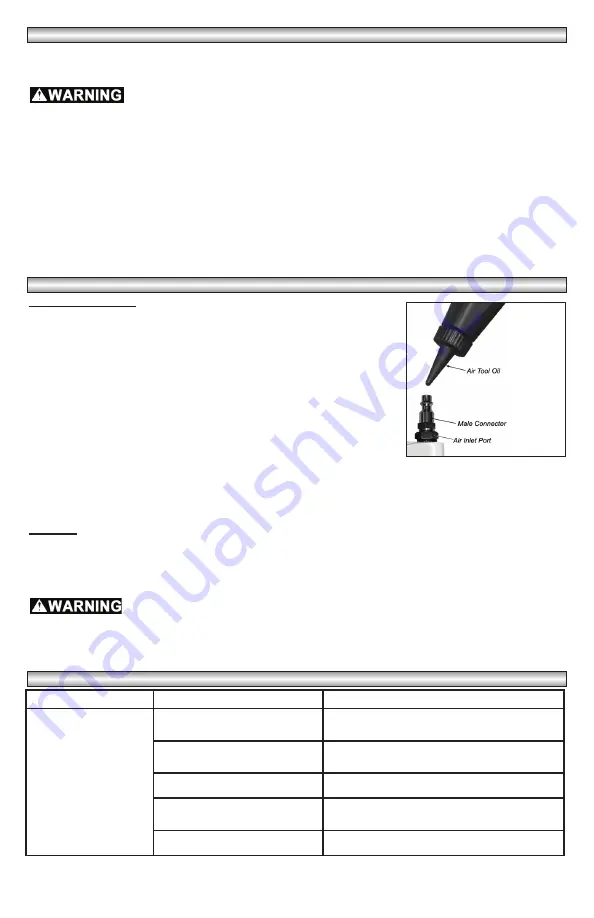
5 - ENG
Air Motor Lubrication
To maintain the maximum performance of the air tool, it must be lubricated
each time it is used. Dust, dirt, rust and oil residue will build up inside the tool
and reduce the performance. An in-line oiler is recommended for proper
automatic tool lubrication (see Figure 1). If an in-line oiler is not available, the
tool can be lubricated manually through the inlet port (see Figure 4).
1. Disconnect the air tool from the air supply and remove the chisel from the
retainer.
2. Turn the tool upside down and while depressing the trigger, add 4-6 drops
of air tool oil or SAE10 nondetergent oil into the air inlet.
NOTE:
Depressing the trigger helps circulate oil in the air motor.
3. Reconnect the tool to the air supply, cover the exhaust port end with a towel and run for approximately 30
seconds to remove excess oil.
NOTE: If the tool remains sluggish after it has been lubricated, the internal components may need to
be cleaned.
To Clean:
Disconnect the air tool from the air supply and remove the chisel from the retainer. Pour or spray a gener-
ous amount of WD-40® into the air inlet with the trigger depressed. Connect the tool to the air supply, cover the
exhaust port end with a towel and run for approximately 30 seconds. Follow the air motor lubrication instructions
above after cleaning is completed to re-lubricate the tool.
After oiling or cleaning, cover the exhaust port with a towel and operate the tool for a
few seconds to safely remove the excess oil. Clean the handle and surface of the tool of any oil residue.
Failure to cover the exhaust port and clean the tool, can result in serious injury.
Note: Keep the towel
away from moving parts!
USER-MAINTENANCE INSTRUCTIONS
TROUBLESHOOTING GUIDE
Figure 4
OPERATING INSTRUCTIONS (continued)
7. Hold the air hammer in an operating position against the work (with chisel properly secured in place) before
depressing the trigger. Squeeze the trigger gently as required to increase or decrease air hammer speed.
Release trigger to stop tool.
Chisel MUST be held firmly against the work surface before depressing the air hammer
trigger. If the tool is not properly positioned against the work and/or the chisel is not properly secured in
the tool before the trigger is depressed, damage to the tool and/or the retainer may result. Regulate the
speed of the air hammer to control the chisel from being driven from the cylinder. Internal damage will
result if the piston strikes the cylinder wall. Remove chisel from tool when not in use.
8. To change chisels (see Figure 3);
a. Pull back the quick-change chisel retainer and push in the chisel (see B).
b. Remove the chisel.
c. Insert the new chisel into the quick-change chisel retainer (see A).
d. Pull back the quick-change chisel retainer and push in the chisel (see B).
e. Release the retainer to lock the chisel into place (see C).
SYMPTOM
POSSIBLE CAUSE(S)
CORRECTIVE ACTION
Tool will not run or runs
slowly
Grit in tool; tool gummed up
Clean the air motor inside the tool with WD-40®
(see “user maintenance” section).
No oil in tool
Add 4-6 drops of air tool oil into the air inlet of
the tool (see “user maintenance” section).
Low air pressure
Adjust compressor regulator to 90 PSI.
Air hose leaks
Tighten and seal hose fittings with Teflon® tape
if leaks are found.
Pressure drops
Do not use excessive couplings between hoses


































